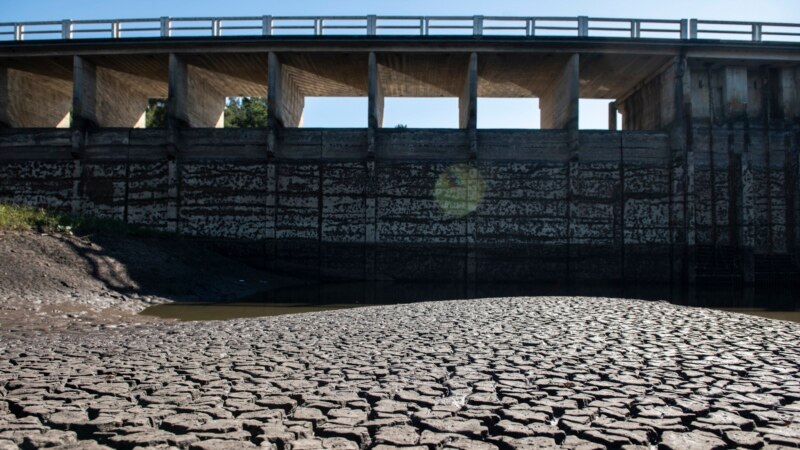
The Uruguayan Federico Hartig always prepared his mate with tap water, but 10 days ago he began to notice a salty taste that was unknown to him.
The 40-year-old cook, who for a decade has been feeding a hundred children in a dining room in the Tres Ombúes neighborhood, on the outskirts of Montevideo, now makes the infusion with bottled water that he also uses for cooking after the children were clear. : “We don’t want to drink that ugly water,” Hartig told The Associated Press.
For more than a week almost two million Uruguayans -out of a total population of 3.4 million- have had to choose between buying bottled water or consuming a saline solution that is impossible to swallow. “The water is not potable (but) it is drinkable,” Environment Minister Robert Bouvier told reporters.
The reason behind the higher salinity in the water that comes out of the tap is the shortage in two reservoirs of the Santa Lucía River, which supplies 60% of the population.
The insufficiency of the liquid has forced the authorities to use water from an area of Santa Lucía close to the Río de la Plata, which registers a higher salinity, with which the sodium levels have risen.
The World Health Organization recommends not exceeding 200 milligrams of sodium per liter of water to make it drinkable, but Uruguayan authorities have said that this value now reaches 440 milligrams.
The crisis is the legacy of “a negligence that comes from afar” and that caused the flow and quality of the Santa Lucía to fail to provide drinking water, Daniel Panario, director of the Institute of Ecology and Environmental Sciences, explained to The Associated Press that since He has been studying the country’s soils and watercourses for more than 50 years. “At this point, without having taken any prior action, there was no other option than to purify saline water,” he said.
a temporary solution
However, it is a short-term solution. Raúl Montero, president of Obras Sanitarias del Estado (OSE), recently warned that there are only reserves for about 18 days. Montero did not specify what could happen after that period.
The Ministry of Public Health recommended that pregnant women and people with kidney disease or heart problems refrain from drinking tap water. “We do not know if tomorrow or in a week we will continue with the same sodium values or not,” Health Minister Karina Rando said at a press conference.
This is not the first water crisis in Uruguay. In 2013 the water acquired an unpleasant smell and taste from algae breeding caused by high levels of phosphorus in the river basin. Livestock and intensive agriculture contributed excessive amounts of minerals and nitrogen to the river, which became cloudy in several areas and also lost volume due to lack of planning.
“We are facing a much more severe drought than usual. But the crisis in Santa Lucía is an accumulation of mismanagement: afforestation in the springs, degradation of resources, agricultural intensification, buffer zones and degraded wetlands, more excessive and unplanned consumption,” explained Marcel Achkar, a researcher at the Institute of Ecology and Environmental Sciences of the Faculty of Engineering of the University of the Republic.
Achkar and other researchers surveyed 486 private reservoirs from the source of the river. When the rains arrive, which are forecast to be less abundant than usual, the reservoirs will fill up before the river that supplies the metropolitan population. The Santa Lucía originates in the high mountains of the department of Lavalleja, a forest area that also suffers from a prolonged drought, located 150 kilometers northeast of Montevideo.
“The mountains store water. When it stops raining, the water continues to come out through the crack for a long time, but the eucalyptus trees consume a good part of that water,” explained Panario.
According to academic research, eucalyptus trees absorb 50% of the water from the springs in the Lavalleja mountains, which were declared a priority for forest plantations.
Last year, wood was the third export product for Uruguay, which has two large pulp mills and another that would come on stream this year. It is estimated that in 2023 it will be the country’s main export, according to the Uruguay XXII government agency. The second is soybeans, which have taken over the country’s most fertile lands in the last 15 years.
“The quality of the watercourses has been fundamentally impacted by the invasion of soybeans. Afforestation also impacts the quantity and quality of water, which by drastically reducing the amount of water in rivers decreases their self-purification capacity,” warned Panario.
In the next few days the government will confirm the construction companies of the Neptuno project, a water treatment plant in the Río de la Plata at a cost of 210 million dollars. It is also studying drilling wells in the Santa Lucía basin and has announced the construction of a new temporary dam.
But these proposals do not convince academics, who prefer to preserve Santa Lucía to stop its deterioration. “We are in time to reverse the processes, prohibit afforestation in the headwaters of the basin, regulate intensive land use, irrigation systems, private dams, improve the treatment of dairy farm water, remove livestock from corral intensive and expedite sanitation. There is a big mess”, summarized Achkar.
Although “there are several points to work on in the medium term,” he assured, the situation is uncertain. The lack of foresight and investment compromise Santa Lucía, while the most populated area of the country drinks salt water and is at the mercy of climatic phenomena to once again have fresh water in the tap.
Connect with the Voice of America! Subscribe to our channel Youtube and activate notifications, or follow us on social networks: Facebook, Twitter and Instagram.


![[Img #74664]](https://thelatestnews.world/wp-content/uploads/2024/12/James-Watson-The-controversial-genius-behind-the-double-helix-150x150.jpg)









